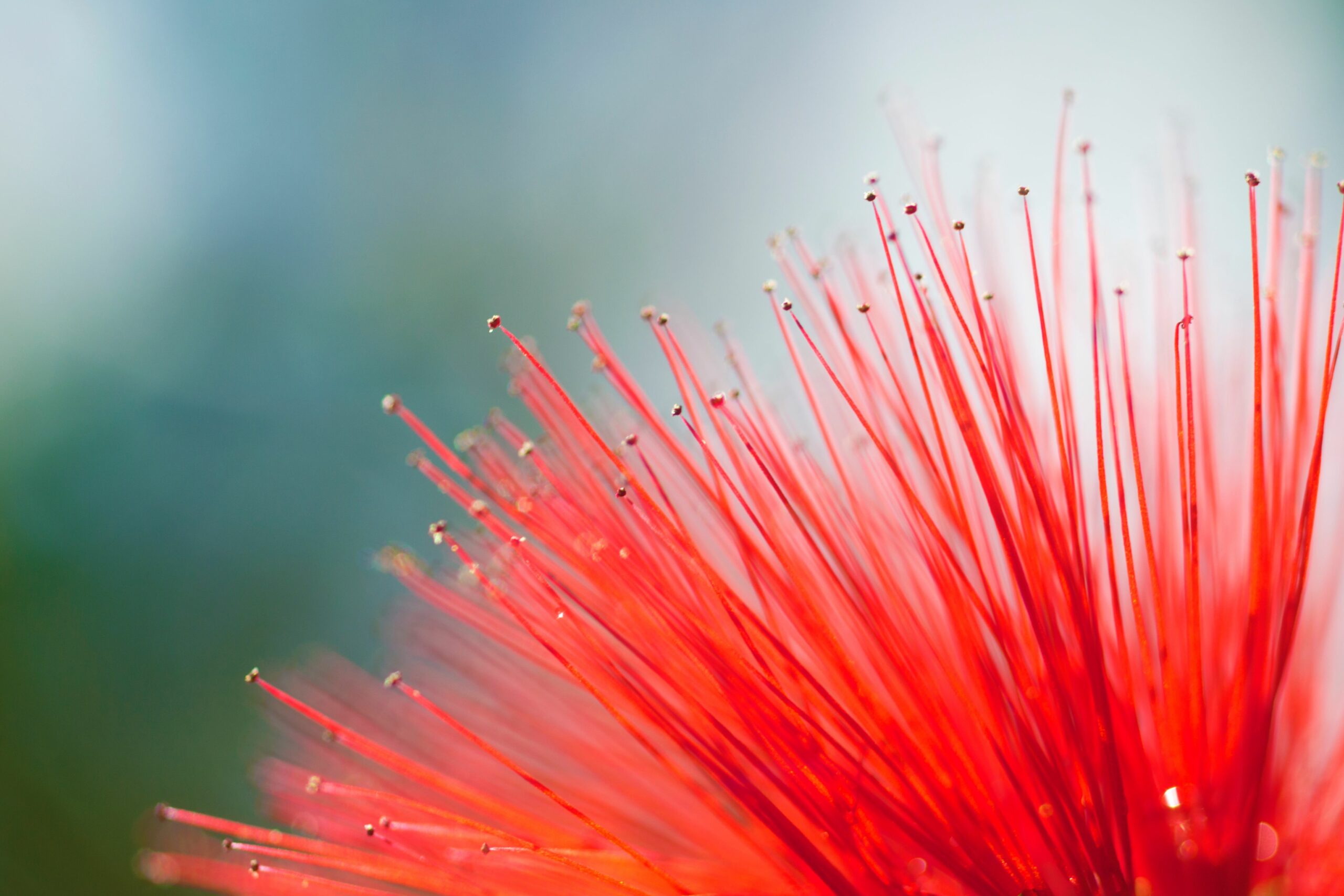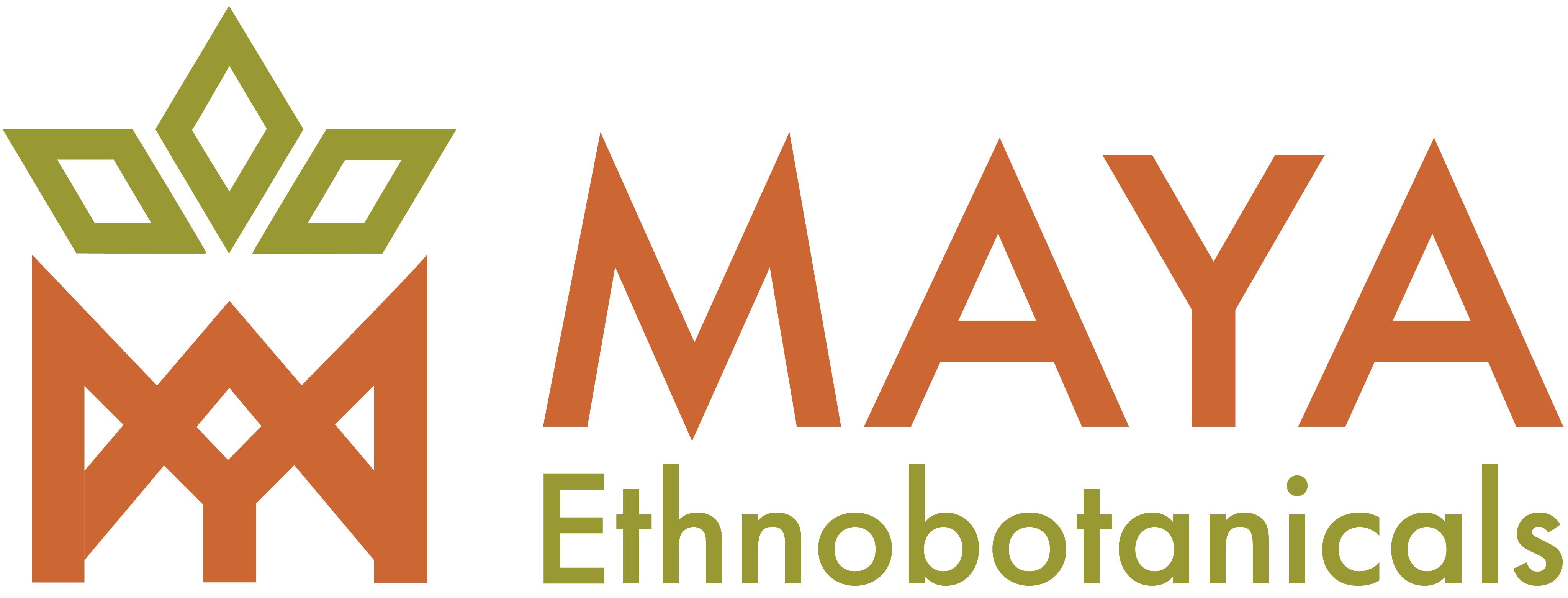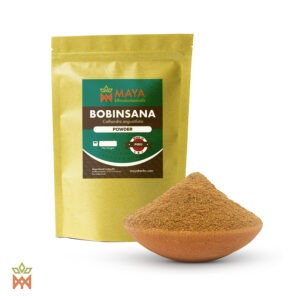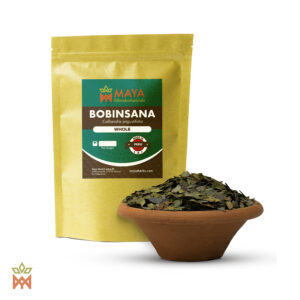Showing all 3 results
- Price range: € 4,75 through € 90,75 Incl. VATSelect options This product has multiple variants. The options may be chosen on the product page
- Price range: € 7,50 through € 75,00 Incl. VATSelect options This product has multiple variants. The options may be chosen on the product page
Showing all 3 results
What is Bobinsana?
Bobinsana, known scientifically as Calliandra angustifolia, is a beloved and revered healing plant endemic to the Amazon rainforest, specifically the jungle regions of Peru, Ecuador, Colombia, Brazil, and Bolivia. It is widely used in Peruvian, Ecuadorian, and Colombian indigenous shamanism as a medicine, a heart opener, and an admixture for the sacred ayahuasca brew.
This slender and graceful shrub loves water and is typically found growing along the banks of waterways of the Amazon Basin. It is especially abundant around the Huallaga and Mayo rivers in Eastern Peru, but it can also be found alongside streams in the warm valleys and cloud forests of the Eastern Andes up to 1500 meters.
Bobinsana belongs to the Fabaceae family, and this can be noticed from the many botanical features it shares with its powerful plant relative Mimosa hostilis — bipinnate leaves, fluffy, vibrant flowers which open up and close early morning and early evening, thin bean pods, and awareness-expanding compounds within its bark, stem, and leaves.
However, unlike Mimosa hostilis and other Amazonian plant species rich in DMT (chacruna and chaliponga), bobinsana contains no potent psychedelic compounds. Still, the chemical cocktail coursing through its body can induce relentlessly reinvigorating and supportive spiritual effects, granting bobinsana its status of Master Plant teacher in Amazonian shamanism.
Traditional Bobinsana Uses
Across its native range, bobinsana has been used since ancestral times as both a healing herb and a portal between our world and the realm of plant spirits.
Medicinal
With its powerful stimulant and therapeutic properties, bobinsana is highly valued among indigenous Amazonian healers throughout Colombia, Ecuador, and Peru.
Along the Rio Pastaza in Colombia, bobinsana root infusions are often drunk as energizing tonics. Similar use is recorded in Ecuador, where the plant also serves as an emetic and a remedy for diarrhea and stress.

In the Peruvian Amazon, various communities reportedly use bobinsana bark and root tinctures (traditionally extracted using a local sugarcane-based alcoholic drink, aguardiente) to treat rheumatoid arthritis, shortness of breath, muscle and bone pain, broken bones, colds, uterine disorders, prolapse, edema, cancer, and various inflammations, as well as to cleanse the blood and prevent pregnancy.
The bark is also grated into a bath which is believed to increase resistance to sickness and provide relief from aches and chills.
Shamanic
Perhaps the most important form of bobinsana use throughout the Amazon involves consuming the plant and communing with its spirit in the context of a shamanic dieta.
Dietas serve for shamans to train their skills and establish connections with the plants they work with. They can last for several weeks or months and involve retreating into solitude, abstaining from social contact with others, surviving on basic nutrition offered by the jungle, and growing, harvesting, and consuming a plant in order to learn from it and build an alliance with its spirit.
By ingesting a plant and meditating under and upon its effects over time, shamans learn to hear and understand its songs, as well as to sing back to its spirit in its own language. This process yields knowledge about what illnesses the plant can heal, what song will summon it, and how it should be prepared.
Each plant communed with this way makes it easier to connect with other plants. Master Plants such as ayahuasca, tobacco, and bobinsana are considered especially valuable allies because their wise and powerful spirits are also knowledgeable about the use of other plants. They don’t need to cause elaborate visionary journeys or even be psychoactive; they can communicate their knowledge to the dietero in a number of different ways.
Bobinsana is ubiquitously loved for its warm, feminine energy and its loving, supportive facilitation of emotional release. If given the time and devotion it deserves, it is said to deepen the dietero’s intuition, ground them in the present moment, enhance their capacity for compassion, improve their overall communication skills, and help heal wounds from loss, grief, and trauma.
Due to these gentle, heart-centered effects, a bobinsana dieta is particularly well-suited for shamanic apprentices or plant medicine practitioners with little experience.
As a spirit, bobinsana is believed to manifest to dieteros in the form of a mermaid or siren. It is inextricably linked with the element of water and is often referred to as the “Sirenita de los Ríos” (Siren of the Rivers), sometimes being associated with the pink river dolphins of the Amazon.
A beautiful icaro song devoted to the spirit of bobinsana has traveled far and wide since its emergence in the Shipibo-Konibo lineage, eventually attaining global popularity. Having been covered countless times, its melody is as approachable to novice musicians as the plant’s effects are to novice practitioners.
Ayahuasca Admixture
In Ecuador, the roots of bobinsana are sometimes added to ayahuasca brews to make them more stimulating in preparation for a physical challenge such as hunting or war.
It’s also said that the presence of bobinsana in the brew can bring more light and emotional colors to the visionary experience, while opening the heart and imbuing it with the feeling of unconditional love. This deepened state of consciousness can enhance the drinker's ability to receive ayahuasca’s teachings.
While many plants are incorporated into ayahuasca brews, primarily for the shamans to gain insight about how to use them, few have remained consistent as admixtures in certain indigenous cultures like bobinsana has.
Whether it’s the purported alkaloid content of the plant (which may additionally facilitate the effects of the DMT when added to ayahuasca), its own stimulating and heart-opening effects, or a synergy of the two, bobinsana is undoubtedly one of the few plant ingredients which can truly make an ayahuasca journey more profound and beneficial to the drinker.
Bobinsana Effects
A bobinsana tea, infusion, or tincture will not produce a psychedelic experience. Instead, this magical plant is typically consumed for its subtle perception- and wellness-boosting effects, as well as its analgesic and anti-inflammatory properties. Its known effects are:
- Enhanced Sensory Perception: Bobinsana is revered for its ability to sharpen the senses. It is said to be able to slow down movement of objects, make colors more vivid, sounds more resonant, and textures more palpable. Practitioners often describe establishing a deep connection with nature and appreciating details that typically go unnoticed in everyday life.
- Lucid Dreams: Bobinsana extract is also frequently taken as an oneirogen. This Master Plant is said to induce vivid and lucid dreams, often featuring communication with sentient entities and regularly yielding profound spiritual insights.Dreams after bobinsana may be longer and more numerous, while feeling more meaningful or even prophetic, and the practitioner’s ability to recall and understand them can be greatly increased under the plant’s effects.
- Pain Relief & Relaxation: Traditional medicine employs Bobinsana tincture against various physical discomforts, including joint inflammations and any types of pain. With these analgesic effects, it’s also able to put practitioners into a deep state of relaxation and groundedness.
Bobinsana Benefits
With regard to how diversely therapeutic bobinsana is, according to Amazonian herbal medicine, the plant has, sadly, not received much scientific interest. Even its chemical composition is not fully known and is often subject to speculation, not just by practitioners but also by researchers.
Still, there has been one study which examined indigenous use of bobinsana for arthritis and it indeed reported the plant’s ability to inhibit cyclooxygenase 1 (COX-1) enzymes, which are responsible for the creation of prostaglandins, which, in turn, signal the early phase of rheumatoid arthritis. It’s not known which bobinsana compounds are behind this effect but this finding supports one of the plant’s primary traditional medicinal uses.
Moreover, a few closely related species have been researched for a few effects bobinsana is traditionally credited with and the results have been promising: Calliandra portoricensis has been found to relieve inflammation, stop cellular death, and restore cellular structure in mammalian breast cancer, and an extract of Calliandra haematocephala is reportedly antiviral and able to treat myocarditis caused by the Coxsackievirus B3.
Beyond the limited scientific knowledge about bobinsana effects, anecdotal reports of the plant’s psychospiritual benefits are plentiful and include:
- Spiritual Growth, Intuition, and Insight: Drinking bobinsana tea is said to deepen intuition and facilitate profound introspection, allowing practitioners to gain important insights into their emotions, relationships, and life purpose. The plant has become a widespread and beloved tool among members of the plant medicine community due to these noble effects.
- Emotional Healing, Catharsis, and Empathy: Bobinsana tincture is said to help open the heart and release pent-up emotions and negative energy, offering a path to emotional catharsis and integration of difficult life experiences such as grief, pain, trauma, or loss. It may also promote feelings of universal unity and interconnectedness with all life, fostering greater love, understanding, and empathy for other beings.
- Enhanced Creativity, Clarity, and Vision: The Shipibo people believe that bobinsana has great affection for beauty and art and is able to catalyze inspiration in the practitioner, opening up channels for creative expression.The combination of insight and inspiration can then bring about more clarity on the practitioner’s present and a more elaborate vision for their future, helping set intentions, define goals, and understand the path they wish to follow.
- Elevated Mood: Dieteros often report experiencing day-long mood boosts after drinking a bobinsana tea or consuming bobinsana tincture or extract. The pain relief, enhanced focus and perception, and elevated emotional functioning and communication the plant catalyzes surely contribute to this overall feeling of potent positivity.
https://youtu.be/1KsNQpKN2Nw
Bobinsana Risks & Side Effects
Bobinsana consumption is considered safe for generally healthy people.
The only word of precaution goes out to women seeking to conceive, as bobinsana bark decoctions are traditionally used as contraceptives in the Amazon. Pregnant women are also advised to avoid bobinsana due to the lack of scientific research into its potential effects during this stage.
How to Prepare Bobinsana
Bobinsana can be prepared and consumed in various ways, each offering a unique experience:
- Bobinsana Tea: The most common method involves brewing bobinsana leaves into tea for about 15 minutes.
- If bobinsana bark is used instead, it will take longer to release the active compounds, so it is advisable to boil it for 30min-1h. For best effect, it can be reboiled up to 2 more times, similarly to brewing ayahuasca vine.
- Bobinsana Tincture: A tincture ensures more precise and consistent dosing. It can be extracted from bobinsana bark by submerging it into high-proof alcohol such as Everclear or vodka in a 1:4 ratio. After 2 weeks with daily agitation of the solution, it will be ready for straining and consumption. The drops can be taken sublingually, added to water and drunk, or applied topically.
- Bobinsana Extract: Bobinsana powder extracts can simply be added to hot water, stirred for a bit, and consumed.
- Bobinsana Bath: Bobinsana-infused baths are used for physical and energetic cleansing and immunity boosting. Traditionally, a bobinsana bath is prepared by simply adding the ground bark to bathwater.
Bobinsana Dosage
The recommended dosage to use when brewing bobinsana tea is 5-15g of leaf or 5-10g of bark per serving, with powder extract dosages correlating to the extract potency.
If a bobinsana tincture is extracted in a 1:4 ratio, the recommended dosage is 2-5ml or ½-1 teaspoon.
How to Take Bobinsana
In order to build a strong and meaningful relationship with the plant, it’s advised to consume bobinsana on its own. There are several ways to maintain a practice:
- Strict dieta — involves drinking bobinsana tea twice daily while maintaining a simple, healthy diet, isolating yourself socially, and abstaining from stress and distractions. By minimizing external stimuli this way, you can achieve the most powerful connection with the plant’s spirit.
- Social dieta — involves drinking bobinsana tea twice daily without following the strict dietary and social restrictions proposed by the dieta. While it's not as effective as the strict dieta, it still allows for some level of connection with the plant and for harnessing its many benefits over time.
- Nightly dream boost — Drinking a cup of bobinsana tea or consuming a teaspoon of bobinsana tincture on an empty stomach before going to sleep may result in longer, more profound, more vivid, or even lucid dreams.
Where to Buy Bobinsana?
Here at Maya Ethnobotanicals, we offer a range of traditional medicinal plants which have been used by indigenous peoples for a variety of purposes since ancient times.
Our products are organically grown, sustainably harvested, and sourced through fair trade, and we sell them with the intention to promote ethnobotanical enthusiasm throughout the world.
If you’re looking for bobinsana for sale, you can find it in our webshop: Buy Bobinsana (Whole Leaf)




